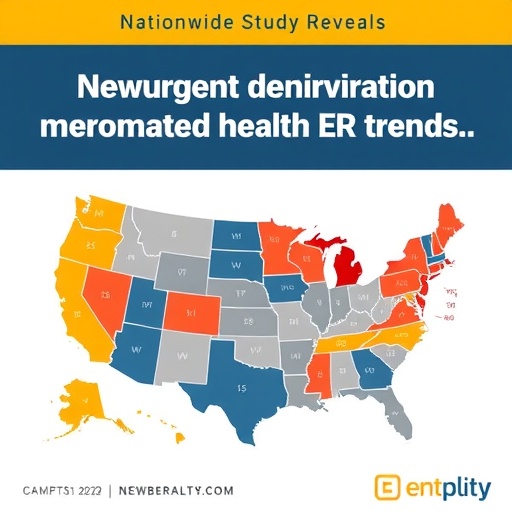In recent years, emergency departments (EDs) around the world have grappled with a growing influx of patients presenting with mental health conditions. Notably, a significant share of these cases are deemed nonurgent, often linked to somatic complaints rather than acute psychiatric crises. Despite their prevalence, the exact impact and implications of these nonurgent mental health presentations have remained somewhat murky, prompting a groundbreaking nationwide study conducted in Germany. This research, spanning a decade of data collection from 2012 to 2022, offers unprecedented insights into the evolving trends and challenges posed by nonurgent mental health visits in emergency settings.
The emergence of mental health patients as one of the top reasons for consultations in emergency departments is no coincidence. Historically, such cases consistently rank as the third or fourth most frequent diagnosis category during ED visits globally. The German study leverages comprehensive outpatient billing data from 16 regional Associations of Statutory Health Insurance Physicians, thereby capturing an extensive dataset that encompasses nearly all emergency cases in general hospitals nationwide. This methodological robustness marks the first time such an extensive surveillance of nonurgent mental health presentations has been carried out on a national scale in Germany.
Analysis of the data reveals a striking upward trajectory in the number of nonurgent mental health cases per 100,000 inhabitants throughout the study period. Particularly from 2016 onwards, this increase not only continued but accelerated, suggesting shifts in underlying factors influencing health-seeking behavior and service utilization. The dataset intricately dissects diagnoses related to cannabis (THC)-induced disorders, depressive episodes, and anxiety disorders, with a focused snapshot from 2019 offering granular understanding of the prevalent conditions contributing to ED visits.
One of the most compelling observations is the pandemic’s dual role in the pattern of ED mental health presentations. The years 2020 and 2021 saw distinguishable pandemic-related fluctuations, likely reflecting the complex interplay between restricted access to outpatient mental health services, social isolation effects, and heightened psychological distress. Following this period, a resurgence and continuation of rising trends in nonurgent mental health presentations were noted, underscoring lasting systemic and societal impacts beyond the immediate crisis years.
Delving deeper, several factors may underpin the rising tide of nonurgent mental health ED visits. Demographic changes, such as aging populations and shifting socioeconomic conditions, are likely contributors. Additionally, increased prevalence rates of mental health disorders, coupled with the documented undersupply of outpatient psychiatric services, exacerbate reliance on emergency departments as points of first contact. This phenomenon raises concerns regarding both the suitability of emergency settings for managing nonurgent psychiatric complaints and the broader adequacy of mental health infrastructure.
The study also casts light on the evolving documentation practices within emergency departments. Enhanced coding and recognition of psychiatric diagnoses may partially explain the observed rise in reported cases. This improved data fidelity, while beneficial for surveillance, hints that previous underreporting might have masked the true scale of nonurgent mental health presentations in emergency care environments. Consequently, the findings emphasize the importance of consistent diagnostic practices and data standardization to better address mental health needs.
Moreover, the study’s implications extend to healthcare policy and system organization. The authors argue for intensified public education initiatives aimed at clarifying appropriate care pathways for mental health crises versus nonurgent issues. There is also a pressing need to expand low-threshold, easily accessible outpatient services, which could divert nonurgent cases from emergency departments, thereby mitigating overcrowding and optimizing care quality.
A pivotal aspect raised involves strengthening the gatekeeper role of general practitioners (GPs) within the regional care system. By enhancing coordination among primary care providers, specialists, and emergency services, patients can be guided more effectively toward appropriate care settings. This improved navigation has the potential not only to alleviate pressures on EDs but also to ensure patients receive timely, continuous, and context-sensitive mental health interventions.
The study’s findings provide essential evidence to inform future research as well. Detailed examination of the socioeconomic, clinical, and systemic drivers behind nonurgent mental health presentations remains critical. Understanding patient motivations, barriers to outpatient service access, and patterns of comorbidity will enrich strategies aimed at reducing ED dependence for mental health issues, particularly those not warranting emergency-level intervention.
Beyond healthcare systems, these trends resonate with broader social and cultural dimensions. Increasing awareness and de-stigmatization efforts around mental health likely influence patient behaviors and expectations, potentially encouraging more individuals to seek help—even when needs are less acute. While positive, this shift necessitates commensurate expansion of appropriate care pathways to prevent overburdening emergency services ill-equipped for routine mental health management.
In conclusion, Germany’s first nationwide investigation into nonurgent mental health presentations to emergency departments underscores a complex and escalating public health challenge. The interplay between demographic shifts, healthcare system gaps, behavioral changes, and data reporting improvements converges to produce increasing ED volumes for mental health concerns that are nonurgent in nature. Addressing this multifaceted issue requires holistic, data-driven interventions spanning policy reform, service provision expansion, and enhanced care coordination.
Ultimately, this landmark study serves as a clarion call for integrated mental health care models that prioritize timely outpatient service access, empower primary care gatekeeping, and better align emergency resources with true psychiatric emergencies. As mental health burdens grow globally, these findings underscore the imperative for sustainable, evidence-informed strategies to optimize patient outcomes and healthcare resource utilization alike.
Subject of Research: Trends and implications of nonurgent mental health presentations in emergency departments based on nationwide outpatient billing data from Germany covering 2012–2022.
Article Title: Trends in nonurgent mental health presentations to emergency departments: insights from the first nationwide study in Germany
Article References:
Kirchner, H., Mangiapane, S., Hu, E. et al. Trends in nonurgent mental health presentations to emergency departments: insights from the first nationwide study in Germany. BMC Psychiatry 25, 855 (2025). https://doi.org/10.1186/s12888-025-07368-0
Image Credits: AI Generated




